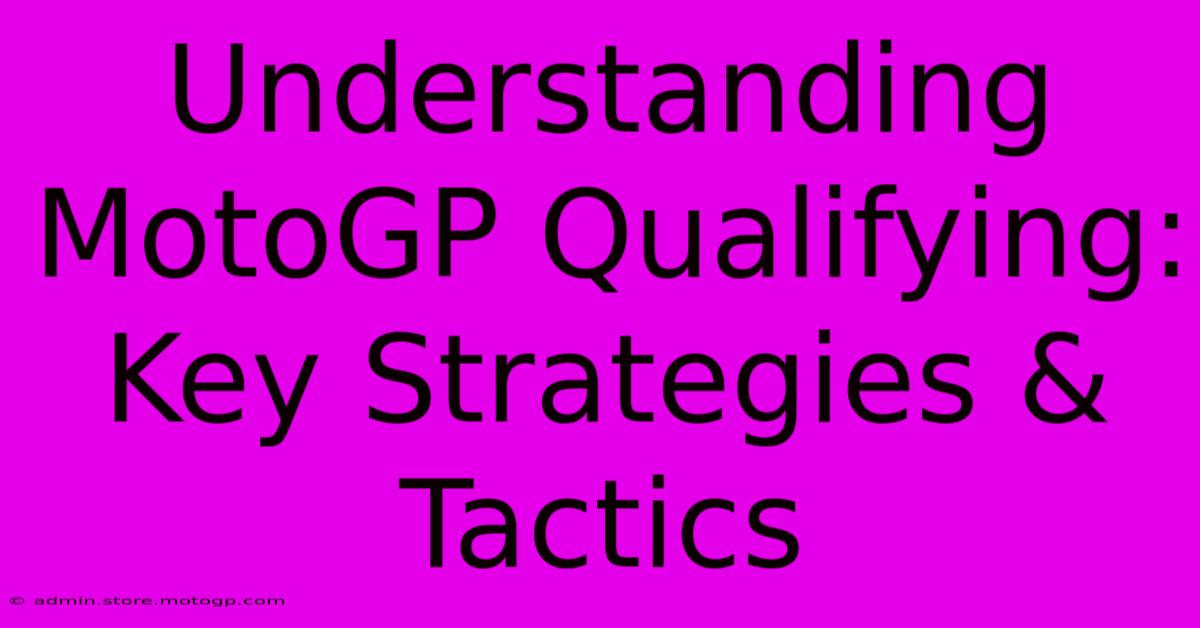Understanding MotoGP Qualifying: Key Strategies & Tactics

Table of Contents
Understanding MotoGP Qualifying: Key Strategies & Tactics
MotoGP qualifying is a crucial part of the race weekend, setting the grid for the Grand Prix. A strong qualifying performance can significantly impact the race outcome, offering a prime starting position and a crucial advantage. Understanding the intricacies of MotoGP qualifying, its strategies, and tactics is vital for any serious fan. This guide will break down the process, revealing the secrets behind securing a pole position.
The Qualifying Format: A Breakdown
MotoGP qualifying follows a tiered system, designed to maximize excitement and separate the fastest riders from the pack. The process typically unfolds as follows:
Q1 (Qualifying 1):
- Participants: The ten slowest riders from the combined Free Practice sessions (FP1, FP2, FP3) participate in Q1.
- Duration: 15 minutes of high-octane action.
- Objective: The top two riders from Q1 automatically progress to Q2. The remaining riders start from positions 13-20 on the grid.
Q2 (Qualifying 2):
- Participants: The top ten riders from the combined Free Practice sessions automatically qualify for Q2, joining the two fastest riders from Q1.
- Duration: Another 15 minutes of intense competition.
- Objective: The grid positions 1-12 are decided based on the final lap times in Q2. The rider with the fastest lap time secures pole position.
Key Strategies & Tactics Employed in MotoGP Qualifying
Winning a MotoGP race starts in qualifying. To secure a desirable grid slot, riders and teams employ several critical strategies and tactics:
Tire Management:
- Choosing the Right Compound: Selecting the appropriate tire compound is crucial. Harder compounds might offer greater longevity but sacrifice speed, while softer compounds provide superior grip for a fast lap but might wear out quickly. Strategic tire choices depending on track conditions and tire wear are paramount.
- Tire Temperature: Maintaining optimal tire temperature is key. Riders need to find a balance between generating enough heat for maximum grip without overheating the tires, leading to a loss of performance. This requires careful riding and understanding of the track.
Slipstream Tactics:
- The Importance of a Tow: MotoGP bikes are highly aerodynamic. Drafting (or slipstreaming) behind another rider significantly reduces air resistance, providing a substantial speed boost. Riders strategically position themselves to gain a slipstream advantage on their qualifying laps. This requires precise timing and teamwork.
- Risk vs. Reward: While slipstreaming offers speed gains, it also carries risks. A slight error in positioning or timing can lead to a crash or loss of control.
Track Knowledge & Line Selection:
- Optimal Racing Line: Mastering the track’s optimal racing line is vital. Every corner offers opportunities for maximizing speed and minimizing time loss. Riders spend considerable time analyzing track data and refining their lines throughout the weekend.
- Finding the Perfect Balance: Finding the perfect balance between speed and safety is critical. Taking unnecessary risks might result in a crash and a compromised qualifying performance.
Mechanical Setup & Bike Adjustments:
- Fine-tuning the Machine: Teams fine-tune bike settings throughout the weekend, optimizing the suspension, electronics, and aerodynamic components for optimal qualifying performance. These adjustments significantly impact the bike’s handling and speed.
- Rider Feedback: Constant communication between rider and team is essential. The rider provides crucial feedback on the bike’s performance, helping the team fine-tune the setup for qualifying.
The Role of Technology in MotoGP Qualifying
Modern MotoGP bikes are equipped with advanced electronics and data acquisition systems. This technology plays a significant role in optimizing qualifying performance:
- Data Analysis: Teams analyze vast amounts of data collected from sensors on the bike, helping them understand tire wear, engine performance, and rider behavior, leading to better setup choices.
- Telemetry: Telemetry data allows riders to monitor their performance in real-time, enabling them to make necessary adjustments to their riding style and technique.
- Track Mapping: Sophisticated track mapping software helps riders visualize the ideal racing line and identify areas for improvement.
Conclusion
MotoGP qualifying is a complex and exciting process, combining strategic planning, precision riding, and cutting-edge technology. Understanding the intricacies of qualifying – from the format and rules to the key strategies and tactics – enhances the enjoyment of the sport and provides a deeper appreciation for the skill and dedication of the riders and teams. The fight for pole position is often as thrilling as the race itself, setting the stage for a breathtaking Grand Prix.

Thank you for visiting our website wich cover about Understanding MotoGP Qualifying: Key Strategies & Tactics. We hope the information provided has been useful to you. Feel free to contact us if you have any questions or need further assistance. See you next time and dont miss to bookmark.
Featured Posts
-
Racing Motorcycles Experience The Difference
Feb 20, 2025
-
Queen Circuit Your Guide To The Ultimate Road Trip
Feb 20, 2025
-
Moto Gp Standings Drama Unfolds On The Track
Feb 20, 2025
-
Cota Austin Schedule Navigate The Weekend Like A Pro
Feb 20, 2025
-
Pure Adrenaline Moto Gp Bike For Sale
Feb 20, 2025
